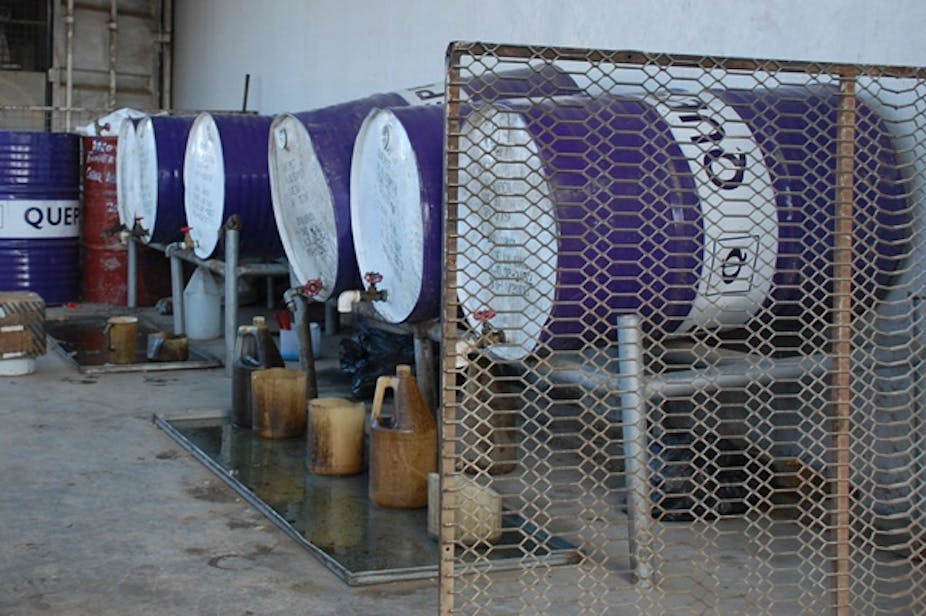When you’re complaining about the price at the bowser next time, consider this. Australia’s oil imports amount to a little over 1% of GDP. In Fiji, the oil import bill was around 14% in 2010. It’s probably higher this year, with oil prices again above the $100/barrel mark. One in every seven dollars of Fiji’s national income is spent on oil, in an economy where there is not much money to start with.
It is an issue for many small island developing states (SIDS) in the Pacific because many rely heavily on oil not just for transport but also to generate electricity. When prices get too high it doesn’t just slow traffic; it turns off the lights as well.
In 2009, the Asian Development Bank estimated that Pacific island economies were among the most vulnerable to oil price volatility in the Asia-Pacific. A large amount of oil is required to produce each dollar of GDP in those countries (because oil powers electricity). And all oil in the Pacific (PNG excepted) is imported, generally at high prices.

The adverse effects of high oil prices in Pacific island countries include inflation, reductions in real household income, and worsening of the terms of trade and balance of payments.
Diesel and oil-based generators produce the majority of power in all but two Pacific island countries (PNG and Fiji are fortunate to generate significant amounts of power from renewable technologies). So high oil prices also raise the cost of electricity and “staple” fuels such as kerosene. This compromises people’s access to energy.
In countries where cost increases are absorbed by state-owned utilities, high oil prices affect the budget. In the extreme case of the Marshall Islands in 2008, this had major fiscal, economic, and social impacts, forcing the government to declare a state of national emergency and requiring a major bailout of the electric utility.
Is there an alternative to oil?
SIDS in the Pacific and elsewhere advocate investment in renewable energy technologies as a response to high oil prices (see the 2008 Pacific Islands Forum Leaders Communiqué for example). There has until now, however, been no analysis of how renewable energy might reduce risk for these nations.

Our research addresses this gap in knowledge. We have assessed investments in renewable technologies on the basis of their impact on both generation cost and financial risk for the electricity grid in Fiji.
The cost benefits of renewables are clear. The technology cost-curve in graph 2 illustrates that there are a number of renewable technologies in Fiji that can generate energy more cheaply than oil.

But in the Pacific, it is also important to consider financial risk. This is an area where energy security, which would mitigate the risk of relying on foreign oil, is particularly important. Renewables are often cited as providing this risk mitigation, but does analysis support this?
We have provided a measure of both the cost and risk-mitigation impact of investments in renewable technologies. We considered these impacts from a system-wide perspective, addressing issues of intermittent power supply from renewable technologies (for example, wind turbines don’t produce electricity when there is no wind, and back-up capacity is needed to prevent shortfalls in power supply).
The results, which consider electricity supply in Fiji in the year 2025, are shown in graph 3. The scenarios include:
an existing renewable technology scenario, where there is no further investment in renewable technologies in Fiji
a scenario that is forecast by the Fiji Electricity Authority (FEA) (the FEA 2015 scenario), and that involves significant renewable technology investments, including investments in biomass, bagasse, hydro-power and geothermal technologies
various other scenarios featuring additional investment in renewable technologies (beyond those envisaged by the FEA).

In Fiji, there are significant cost-reduction and risk-mitigation benefits from investing in renewable technologies. The scenarios that have lower expected average costs generally also have the lower cost risks. And these benefits tend to increase with the extent of renewable energy in the overall portfolio.
However, not all investments are equal. Most beneficial from a risk/cost perspective is investment in low-cost renewable technologies. This includes geothermal, energy efficiency, biomass, and bagasse technologies, which have among the lowest generation costs of any technology in Fiji (less than 23 FJc/kWh - see graph 2). Biomass and bagasse technologies are linked to the timber and sugar industries in Fiji; a geothermal power plant could be installed in an area of Fiji known to have “hot rocks”. All three technologies could commence operations in several years.
Energy efficiency technologies could be promoted through energy labelling and mandatory energy performance standards, based on standards already in place in Australia and New Zealand.
In contrast, high-cost renewable technologies such as wind and solar-power (which have generation costs above 48 FJc/kWh - see graph 2) reduce financial risk but increase generation costs.
Investing in hydro-power, the flagship renewable energy program of the Fiji Government, decreases financial risk but has a minimal impact on generation costs.
Which power should the Pacific choose?
In Fiji, further investment in low-cost, low-risk renewable technologies should be encouraged on energy security grounds, and with the goal of lowering generation costs in the electricity grid. These investments should be prioritised over investment in hydro-power generation capacity. The Fiji Government’s focus on hydro-power projects is mistaken when considered from a system-wide perspective.
More broadly, the results highlight the importance of considering financial risk as well as generation cost when planning investments in electricity generation capacity.
This is relevant in other Pacific island countries and small island developing states. The electricity sector in the majority of these countries is dominated by oil-based power generation. This sector is vulnerable to oil price increases and oil price volatility: both are predicted in the coming decades by the International Energy Agency.

